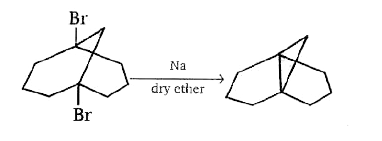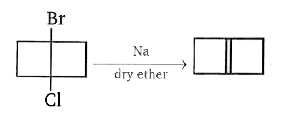Which of the following does not represent the correct product?




The correct Answer is:C
To determine which of the given reactions does not represent the correct product, we will analyze each reaction step by step.
Step 1: Analyze Reaction A
- Reactants: 2-bromo-2,3-dimethylbutan-3 and Ag+
- Mechanism: The bromine leaves, forming a carbocation. The methyl group migrates to stabilize the carbocation.
- Product: The final product is 3,3-dimethyl-2-butanol or butan-2-ol.
- Conclusion: This reaction is correct.
Step 2: Analyze Reaction B
- Reactants: 2,3-butanediol and H+
- Mechanism: Protonation of the hydroxyl group leads to the formation of a carbocation after water leaves. The hydrogen from the adjacent carbon migrates.
- Product: The final product is butanone.
- Conclusion: This reaction is correct.
Step 3: Analyze Reaction C
- Reactants: 2,3-butanediol and H+
- Mechanism: Protonation occurs, leading to the formation of a carbocation. The phenyl group migrates to stabilize the carbocation.
- Product: The expected product is 3,3-diphenyl-2-butanone.
- Conclusion: The product is incorrect because the phenyl group should migrate, but the product does not reflect this correctly.
Step 4: Analyze Reaction D
- Reactants: 3-amino-2,3-dimethyl-butan-2-ol and Na2HCl
- Mechanism: The nitrogen lone pair attacks, forming a nitrophonium ion. The nitrogen leaves, forming a carbocation, and a methyl group migrates.
- Product: The final product is 3,3-dimethyl-butan-2-one or butan-2-one.
- Conclusion: This reaction is correct.
Final Conclusion
- Incorrect Product: Reaction C does not represent the correct product as the migration of the phenyl group is not accurately depicted in the product.
Answer
The reaction that does not represent the correct product is C.
---
- Reactants: 2-bromo-2,3-dimethylbutan-3 and Ag+
- Mechanism: The bromine leaves, forming a carbocation. The methyl group migrates to stabilize the carbocation.
- Product: The final product is 3,3-dimethyl-2-butanol or butan-2-ol.
- Conclusion: This reaction is correct.
- Reactants: 2,3-butanediol and H+
- Mechanism: Protonation of the hydroxyl group leads to the formation of a carbocation after water leaves. The hydrogen from the adjacent carbon migrates.
- Product: The final product is butanone.
- Conclusion: This reaction is correct.
- Reactants: 2,3-butanediol and H+
- Mechanism: Protonation occurs, leading to the formation of a carbocation. The phenyl group migrates to stabilize the carbocation.
- Product: The expected product is 3,3-diphenyl-2-butanone.
- Conclusion: The product is incorrect because the phenyl group should migrate, but the product does not reflect this correctly.
- Reactants: 3-amino-2,3-dimethyl-butan-2-ol and Na2HCl
- Mechanism: The nitrogen lone pair attacks, forming a nitrophonium ion. The nitrogen leaves, forming a carbocation, and a methyl group migrates.
- Product: The final product is 3,3-dimethyl-butan-2-one or butan-2-one.
- Conclusion: This reaction is correct.
- Incorrect Product: Reaction C does not represent the correct product as the migration of the phenyl group is not accurately depicted in the product.
The reaction that does not represent the correct product is C.
Topper's Solved these Questions
- ORGANIC REACTION MECHANISMS-IVBOOK - RESONANCE ENGLISHCHAPTER - ORGANIC REACTION MECHANISMS-IVEXERCISE - Exercise-1 Part-3
2 Videos
- ORGANIC REACTION MECHANISMS-IVBOOK - RESONANCE ENGLISHCHAPTER - ORGANIC REACTION MECHANISMS-IVEXERCISE - Exercise-2 Part-1
11 Videos
- ORGANIC REACTION MECHANISMS-IVBOOK - RESONANCE ENGLISHCHAPTER - ORGANIC REACTION MECHANISMS-IVEXERCISE - APSP PART-3
22 Videos
- ORGANIC REACTION MECHANISMS - IIBOOK - RESONANCE ENGLISHCHAPTER - ORGANIC REACTION MECHANISMS - IIEXERCISE - APSP Part - 3
22 Videos
- PERIODIC TABLE & PERIODICITYBOOK - RESONANCE ENGLISHCHAPTER - PERIODIC TABLE & PERIODICITYEXERCISE - ORGANIC CHEMISTRY(BASIC CONCEPTS)
27 Videos
Similar Questions
Knowledge Check
Which of the following values does not represent the correct value of R ?
A8.314 Pa m3K−1mol−1B8.314×102bar LK−1mol−1C0.0821jk−1mol−1D8.314jk−1mol−1Which of the following does not represent major product of the reaction ?
A B
B C
C D
D
Which of the following does not represent the correct order of the properties indicated ?
View SolutionWhich of the following reaction represents the correct product formation?
View SolutionWhich of the following does not represent a correct set of nucleophile -
View SolutionWhich of the following does not represent zero?
1+0
View SolutionWhich of the following does not represent redox reaction?
View SolutionWhich of the following does not represent zero?
0×0
View Solution
